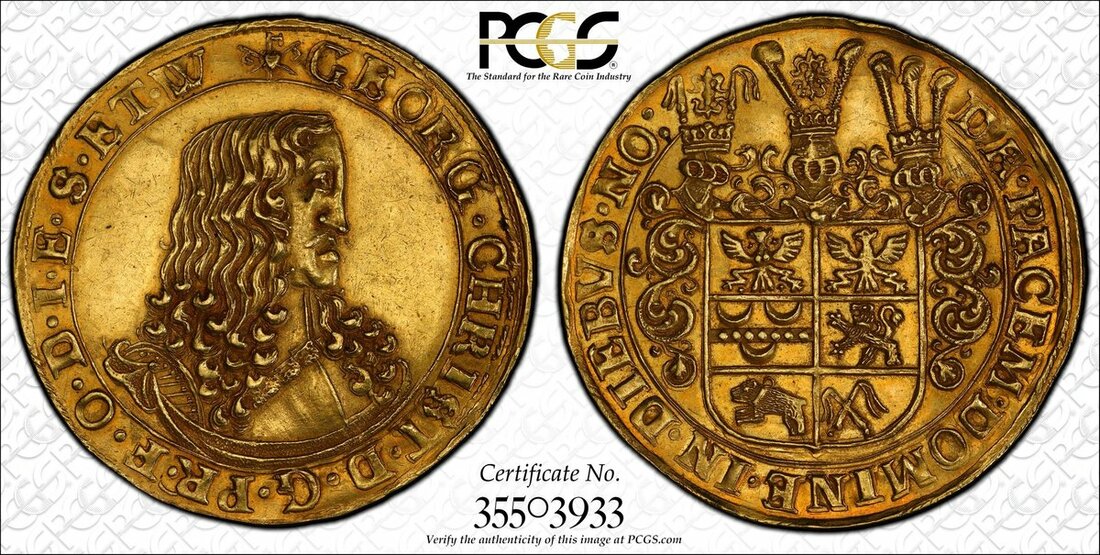Auction: 21007 - British and World Coins Autumn Auction
Lot: 228
Germany, East Friesland, Georg Christian, Imperial Prince of Ostfriesland, Lord of Esens, Stedesdorf and Wittmund (1660-1665), Gold Medal of 8-Ducats, struck from the Official Thaler dies, 18 April - 10 May 1662, by J Esens, Münzmeister Borchert Hartmann, Emden, (m.m.) GEORG · CHRIST · D · G · PR · F · O · D · I · E · S · ET · W, charmingly crude bare-headed, draped and cuirassed bust right, rev. D : A · PACEM · DOMINE · IN · DIEBVS · NO: elaborately ornamented tri-helmeted coat-of-arms of East Frisia with falling garnish, edge plain, 28.43g, 5h (cf. KM 102.2; cf. Dav 7129; cf. Reimmann 5421; Fb. 890), a trace of doubling in legends and wisps of surface friction in fields, otherwise residually lustrous with hues of golden-orange in deepest recesses, of the highest rarity in any metal, presumed UNIQUE in gold, in PCGS holder, graded AU55 (Cert. #35503933)
Since its first auction appearance in New York in 2018, this coin has mystified and enchanted the East Frisian and wider German numismatic community. The story of Prince Christian Georg is little known, as too are the extremely rare Thalers struck for his short reign in the middle of the 17th Century. Those unfamiliar to the series would perhaps more happily equate the size and method of striking of this coin with the contemporary Triple-Unites struck for the English Civil War, or indeed the 10-Ducat strikings of the Holy Roman Empire seen next.
Consequently limited academic interpretation has been offered for this very elusive series, of which varieties of the silver specie are still being discovered, as evidenced by the 1.5-Reichstaler (Künker Auction 93, 23 June 2004, lot 4354). Since this time only one cleaned Thaler (Heritage, NY Signature Sale 6 January 2014, lot 23631 [XF-Details ~ Surface Hairlines] and another formerly in the Brand collection have surfaced (Künker Auction 127, 20 June 2007, lot 3629) and resurfaced at global public auction. With a corpus this millennium effectively standing at just three silver strikings and one gold, one would be hard pressed to deduce much at all. However the story of Georg Christian undoubtedly provides us with important context that is otherwise frustratingly absent from this otherwise handsome and enigmatic coinage.
His accession to the Principality on 4 April 1660 effectively secured the hereditary ambition of his elder brother and predecessor Enno-Louis, who had sought to establish himself as Reichsfürst with the help of an East Frisian scholar Hermann Conring and 15,000 guilders in 1654. However his death and Georg Christian's accession were hampered by protocol. It was not until 18 April 1662 that the Cirksena Dynasty received the appropriate elevation to Imperial Prince from the Holy Roman Emperor to allow him to marry Christine Charlotte, daughter of Duke Eberhard III of Württemberg. They had met whilst studying together at the University of Tübingen. Following this marriage 'to the right hand' at Stuttgart on 10 May, it has been presumed that this attractive series was struck. On the balance of probability the absence of the cognizances of Württemberg would suggest a commemorative striking in relation to the former, but perhaps in distribution thereafter.
However what is not in doubt is the impressive surge in collecting interest in ultra-rare large denomination German states gold presentations since this coin last appeared, as most notably testified by the Paramount sale in March 2021. Therein the lauded and equally unique Memmingen 10-Ducat of 1623 (lot 30259, MS62+) attained an impressive $384,000 (~ £280,000); the Hanau-Lichtenberg 10-Ducat of 1695, also the sole known specimen (lot 30245, AU58) fetched $322,000 (~ £270,000) and the Regensburg Medallis 6-Ducat of 1745-65 (lot 30266, MS62*) fetched $240,000 (~£175,000).
Subject to 20% VAT on Buyer’s Premium. For more information please view Terms and Conditions for Buyers.
Estimate
£150,000 to £200,000
Starting price
£150000







